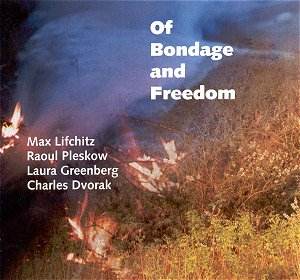The indefatigable driving force of North/South Consonance
and a brilliant pianist specialising in contemporary music, Max Lifschitz
is also a distinguished composer as is evident when listening to his
beautifully moving Of Bondage and Freedom of 1991. Three
movements are for voice and instruments, setting poems by the Jewish
poet Abraham Sutzkever and by the Nobel winning Catholic Polish writer
Czeslaw Milosz. These moving texts are set in a wide variety of language
and of style. The Sutzkever A Cartload of Shoes is sung in Yiddish
whereas the Milosz poem Campo di Fiori is sung partly
in the original Polish and partly in English translation. However, the
opening section, Premonitions, is an elegiac introduction for
solo violin. A Cartload of Shoes is quite effectively set for
soprano and violin whereas Campo di Fiori (i.e. a park in Rome)
gathers the three players (soprano, violin and piano). The vocal writing
here sometimes turns to Sprechstimme to telling effect. Remembrance,
for violin and piano, is based on a Yiddish tune and briefly quotes
from a piece by Schumann, as a faint echo from times past. The final
section Libera Me sets fragments from Milosz and Sutzkever as
well as from the Book of Job.
Raoul Pleskow’s Two Arabesques (1988)
is a highly contrasted diptych scored for a small mixed ensemble of
winds, strings and piano. Pleskow’s music is a fairly traditional blend
of tonal and atonal elements, and is characterised by fairly complex
contrapuntal writing.
Laura Greenberg’s La Vida Es Sueño
(1988) for soprano and six players sets parts of a soliloquy from a
play by Calderón de la Barca, which is some sort of Spanish equivalent
to Hamlet’s To be or not to be. Her Kenneth Patchen setting This
Man Was Your Brother (1979, soprano and seven players including
three percussionists) is evidently quite different in mood. The percussive
qualities of the instrumental writing emphasise the quickly changing
moods of the poem.
In Amandla Mandela! (1991), Charles Dvorak
sets a number of texts by Nelson Mandela dealing with the social and
political situation in South Africa and with his own imprisonment. The
piece is scored for narrator, clarinet, double bass, piano and percussion
(two players). For nearly ten minutes, the work is a melodrama for narrator
and timpani (the effect is not unlike that of Spring Offensive
from Bliss’s Morning Heroes). The music then discreetly
steals in. It is based on John Coltrane’s song Alabama; and its
presence grows as the narration moves on. It reaches a short jazzy section
with prominent percussion. This undoubtedly sincere work is nevertheless
let down by the comparative lack of music. A pity indeed for the actual
music played by the ensemble is simple, straightforward and very attractive
in its simplicity. There is just too little of it.
This well-planned, well-played and well-recorded selection
is on the whole very interesting and has some fine music to offer. It
is well worth investigating. A typical North/South Consonance enterprise
exploring some little-known by-ways of the American musical scene.
Hubert Culot


